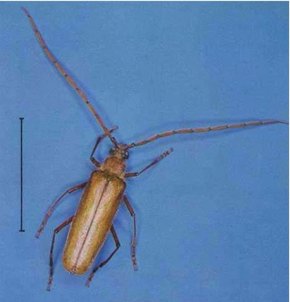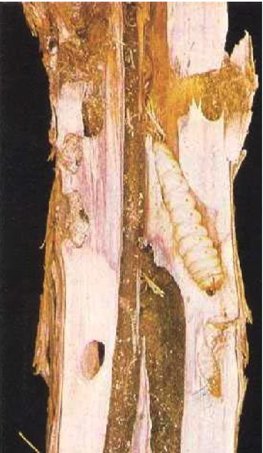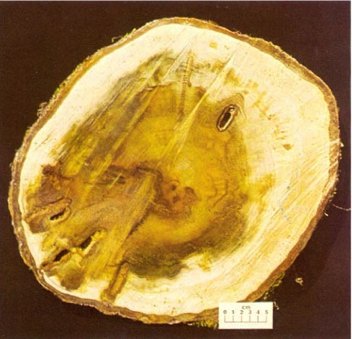PESTS AND DISEASES OF FORESTRY IN NEW ZEALAND
Kanuka longhorn
Scion is the leading provider of forest-related knowledge in New Zealand
Formerly known as the Forest Research Institute, Scion has been a leader in research relating to forest health for over 50 years. The Rotorua-based Crown Research Institute continues to provide science that will protect all forests from damage caused by insect pests, pathogens and weeds. The information presented below arises from these research activities.
Forest and Timber Insects in New Zealand No. 30: Kanuka longhorn.
Revised 2009
Based on G.P. Hosking (1978)
Insect: Ochrocydus huttoni Pascoe (Coleoptera: Cerambycidae)

Fig. 1 - Ochrocydus huttoni adult.
The line shows natural length.
Type of injury
The larvae of Ochrocydus huttoni excavate longitudinal tunnels in the living stem of the host, and make short lateral tunnels leading to surface openings through which bore dust is ejected (Fig. 2). The larval tunnels are oval in cross section and about 15mm at their widest point. They may exceed 1m in length. An accumulation of bore dust on or about the lower stem of a living host is generally an indication of advanced infestation.
Hosts
Leptospermum scoparium (manuka) and Kunzea ericoides (kanuka) are the main hosts but Nothofagus solandri var. cliffortioides (mountain beech) and N. fusca (red beech) may also suffer damage especially when close to Leptospermum. There are also a few records from Quercus spp. (oaks) and Agonis juniperina (juniper myrtle).
Distribution
This native insect has been recorded in most places in New Zealand but not in Otago.
Economic importance
The larval tunnels in the outer sapwood of living beech trees may result in the loss of usable timber (Fig. 3). Wetas, often present as secondary inhabitants of O. huttoni tunnels in beech, keep the tunnel system open and allow the entry of stem-rotting fungi.

Fig. 2 - Larva of O. huttoni in manuka.

Fig. 3 - Oval tunnels made by O. huttoni larvae in the sapwood of living mountain beech.
Description, life history and habits
The adult is a longhorn beetle (Fig. 1) up to 35 mm long and resembles the huhu beetle (Prionoplus reticularis) in general body form. The antennae, which are composed of smooth, stout, elongated segments, extend about 11/4 body lengths in the male, but in the female do not reach as far as the end of the body. In freshly emerged specimens the thorax and head are covered with light brown hairs. In older beetles these hairs become somewhat worn away to reveal a dark brown to black surface. The thorax is narrower than the elytra (wing cases) which are light brown and have slightly tapering sides, a slightly ridged parallel venation, and an irregular pattern of shallow punctures. The elytra lack the strong net-like pattern of the huhu beetle but have a pair of more distinct spines at their rear ends. The abdominal segments, visible on the underside, are light brown with a darker brown band along each rear margin.
The larva, which may be up to 60 mm long, is creamy yellow, the head bearing conspicuous jaws which are rounded at the tip and gouge-like. The top of the prothorax bears stout bristles along its front margin. On either side of each body segment except the third thoracic and ninth abdominal segments, there is a large oval breathing pore. Legs are well developed compared with those of many other longhorn beetle larvae.
The larvae tunnel in living trees, and the longitudinal tunnels rapidly become discoloured with a black fungus. The pupal chamber, which may be up to 25 mm wide and 120 mm long, is plugged at both ends with coarsely shredded wood. A short horizontal tunnel, later used by the emerging adult, leads from the pupal chamber and ends just short of the surface of the host tree. Adults are known to fly in the early summer months.
Control
No control measures are practical or considered necessary against this insect.
Bibliography
Dumbleton, L.J. 1957: The immature stages of some New Zealand longhorn beetles (Coleoptera : Cerambycidae). Transactions of the Royal Society of New Zealand 84: 611 - 628.
Hosking, G.P. 1978: Ochrocydus huttoni Pascoe (Coleoptera: Cerambycidae), kanuka longhorn. New Zealand Forest Service, Forest and Timber Insects in New Zealand No. 30.
This information is intended for general interest only. It is not intended to be a substitute for specific specialist advice on any matter and should not be relied on for that purpose. Scion will not be liable for any direct, indirect, incidental, special, consequential or exemplary damages, loss of profits, or any other intangible losses that result from using the information provided on this site.
(Scion is the trading name of the New Zealand Forest Research Institute Limited.)

 Farm Forestry New Zealand
Farm Forestry New Zealand

